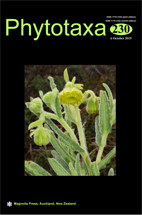Abstract
Ainsliaea brandisiana was regarded as distributed only in southeastern Myanmar. Koyama once reported the occurrence of A. brandisiana in Thailand in 1983, whereas Tseng thought it was a new species and described it as A. spnocephala in 1988. This treatment was accepted by Freire in 2007. Thus, the record of A. brandisiana from Thailand reported by Koyama was not valid. However, during a field trip in Phu Soi Dao National Park of northeastern Thailand, we found a remarkable species of Ainsliaea growing in mountain forests at the elevation of 1600 m. After detailed and comprehensive examination, we determined that it was A. brandisiana. This “rediscovered” record of A. brandisiana suggested a close phytogeographical connection between the mountain forests flora of southeastern Myanmar and that of northeastern Thailand, although they were separated by the lowlands rain forests of Thailand peninsula. We proposed a new hypothesis that there might be a plant migration route connecting southeastern Myanmar, northeastern Thailand and the Hengduan Mountains. Here, we described and illustrated A. brandisiana and provided photographs of its live specimens in the field, its habitat, morphological details of its floret, its distribution map and a key to all the known species of Ainsliaea from Thailand.

